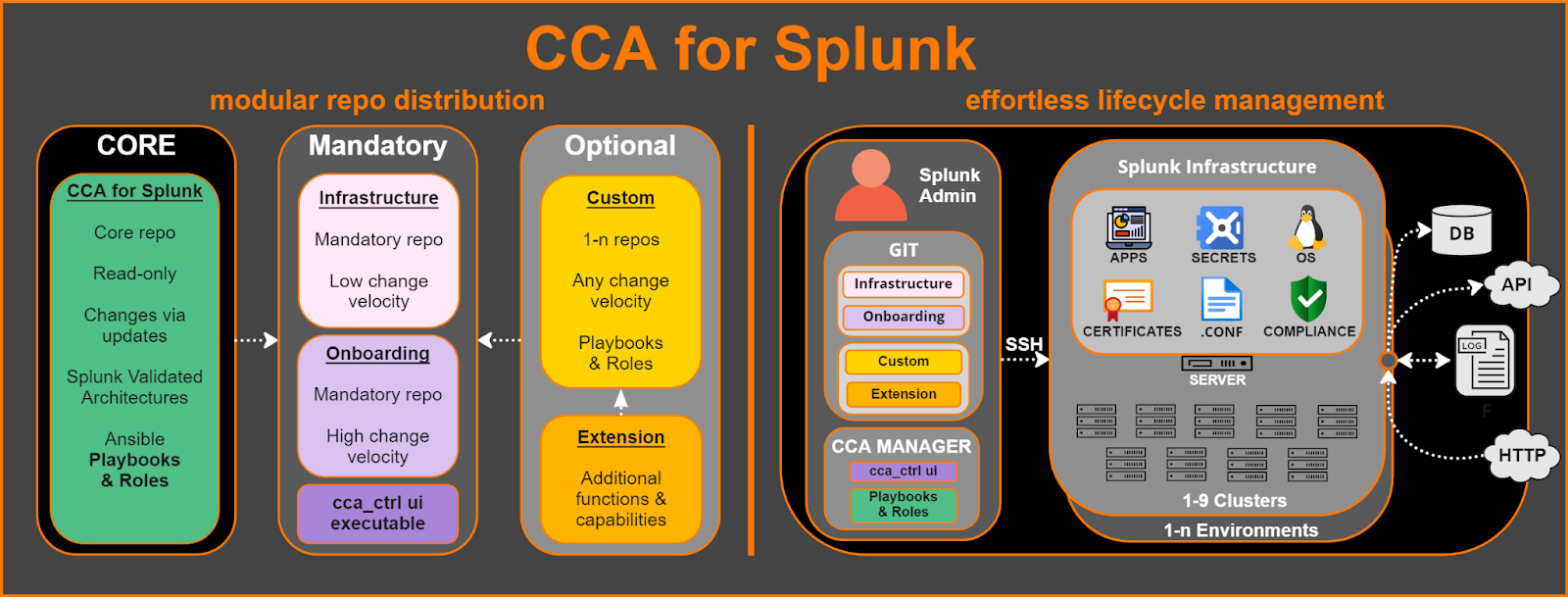Automating Splunk platform administration with a Continuous Configuration Automation framework
As Splunk deployments scale, maintaining control over your Splunk Enterprise configuration settings through upgrades, app deployments, and data onboarding and day-to-day support can become increasingly difficult to manage efficiently while also upholding digital resiliency.
If you have Splunk Cloud Platform, platform administration is provided as a service, yet the data footprint on-prem and in-the-cloud that fuels Splunk Cloud Platform still requires a significant administration effort. As Splunk deployments scale, maintaining control over your Splunk installations outside of Splunk Cloud Platform, requires Splunk Enterprise configuration, upgrades, app deployments, and data onboarding. These day-to-day activities can become increasingly difficult to manage without similar efficiency in the administration like that offered by Splunk Cloud Platform.
Different types of users need to be able to work with the Splunk platform quickly and efficiently in order to meet the needs of their roles:
- Splunk admins need to keep up with day-to-day administration tasks, follow all internal policies, and effectively handle external pressures, while also keeping up with implementing new features from the Splunk ecosystem.
- Splunk service owners need to provide services that meet continuously changing business needs while planning for business continuity through upgrades, data onboarding requests, incompatibility between apps and versions, or issues scaling the platform to meet capacity and performance demands.
- Splunk business owners need to ensure that Splunk platform achieves data goals and also boosts their business' data capabilities.
- Splunk app developers need to ensure that time to value of development is managed effectively through accessing the right data and using effective SPL queries.
- Splunk consultants need to help their clients succeed through balancing efficient Splunk platform operations with business value adding use of the technology.
Managing these tasks while maintaining administrative control can be complex in larger deployments, and can result in either speed or quality dropping. In complex deployments, for example those running several dedicated multi-site index and search head clusters with each handling tens of TBs of data, automation frameworks are often needed to ensure efficiency. Even if you're running a single Splunk Enterprise instance with just a couple of GBs of data, you might also be interested in implementing an automation framework right from the start to ensure scalability for the future.
Solution
CCA for Splunk gives you a central interface to interact with all aspects of Splunk platform architecture and administration. It enables a full lifecycle management of your Splunk platform deployment using a Continuous Configuration Automation framework powered by Ansible, so you can manage certificates, upgrades, and app deployments with full control and flexibility. This provides benefits to all roles listed above, whether they are direct or indirect users of the Splunk platform.
The CCA for Splunk framework is built with a modular architecture and comes with an extensive set of Ansible playbooks and roles that helps with Splunk administration in different ways:
- Parameterized. Modify each parameter only once, independent on how many actual configuration files may utilize it, for perfect compliance at scale.
- Decoupled. Separate the automation from the Splunk platform installation configuration to update either without breaking the other.
- Change verification. Use Ansible check-mode to view and verify all proposed changes for deployment to avoid issues before they are implemented.
- Splunk installation. Install the Splunk platform in an easy and controlled way, with security enabled right from the start.
- Splunk & OS upgrade. Plan and perform upgrades methodically, efficiently and predictably, with full control of each technology layer.
- OS configuration. Enable a secure and optimized setting for your host OS to compliment your Splunk platform best practices.
- Splunk certificates. Distribute and control your own certificates for all Splunk platform services.
- Splunk security enablement. Implement Splunk platform recommendations and best practices by default and maintain full integrity sustainably over time.
- Splunk data onboarding. Control different types of data onboarding, from deployer configuration, to HTTP Event Token management, to add-ons like DB Connect, all fully configured after deployment.
- Centralized app repository. Use the version-controlled repository to handle the right app version for the right Splunk platform version, enable multi stage environment test, and deployment schemes with easy knowledge bundle distribution.
- Centralized configuration repository. Create and work towards an abstraction of the configuration of your Splunk environments, effectively enabling a modern software development approach to Splunk platform management.
- Disaster recovery. Automatically keep an up-to-date version controlled state of all infrastructure and app configuration to rebound fast in case of emergency.
- Extension support. Extend CCA with new capabilities to cover niche or custom use cases with complimentary playbooks and roles, within or outside Splunk platform via integrations.
Next steps
First, watch the .conf22 session PLA1151B - To the moon – A one-way ticket to effortless Splunk management with Ansible to see a demo of the framework applied in a Splunk platform deployment.
Next, go to the CCA for Splunk Github repo to download, install, and get started with the open source version of the framework.
If you need further guidance or enterprise support for CCA for Splunk, Orange Cyberdefense can help.
The user- and community-generated information, content, data, text, graphics, images, videos, documents and other materials made available on Splunk Lantern is Community Content as provided in the terms and conditions of the Splunk Website Terms of Use, and it should not be implied that Splunk warrants, recommends, endorses or approves of any of the Community Content, nor is Splunk responsible for the availability or accuracy of such. Splunk specifically disclaims any liability and any actions resulting from your use of any information provided on Splunk Lantern.


